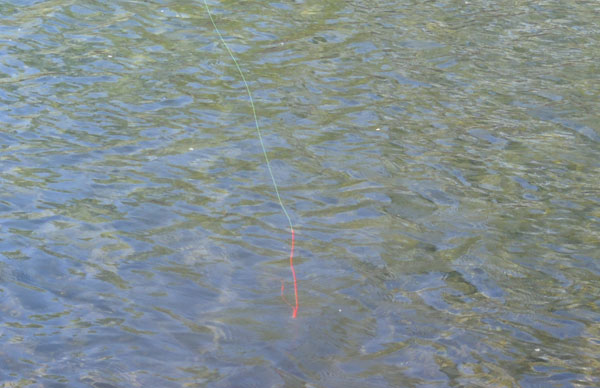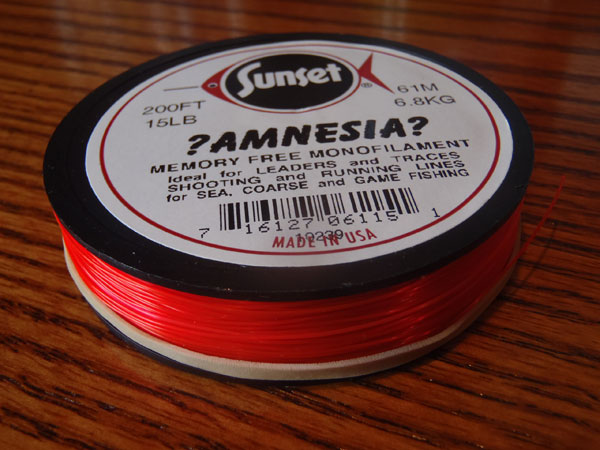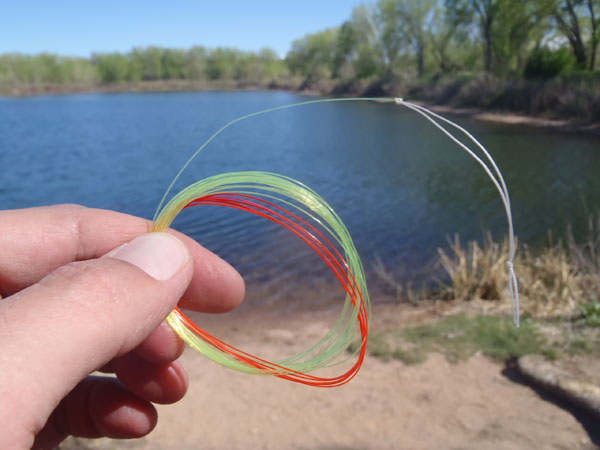Anyone who has ever dead drifted a fly with a tenkara rod has undoubtedly discovered two things: 1. Sometimes it’s hard to detect a strike on a level line. 2. Strike indicators don’t cast well with a tenkara rod. Luckily, for anyone who finds it difficult to see their line, there’s a simple way to more easily detect strikes without slinging an awkward, cast spoiling strike indicator.
Even the brightest fluorocarbon tenkara level lines can be difficult to see under certain lighting conditions. I sometimes switch colors (between orange and yellow) depending on the time of day and amount of glare on the water so I can see the line more easily. But the last few times I’ve been out, I’ve been using an idea that Tom Davis of Teton Tenkara came up with. He adds 3 ft. of red Amnesia mono to the end of his tenkara level line as a strike indicator. Since it’s just monofilament, it doesn’t interrupt the cast the way a typical hard bodied or yarn indicator does. The red color is so bright, it almost glows and in my testing, I’ve been able to more easily detect even the most subtle strikes under a range of lighting conditions.

Tom uses 15 lb. Amnesia and while this works well, a recent discussion with Karel from Tenkara on the Fly has got me thinking that I might try a thinner diameter like 10 lb. or 12 lb. A thinner diameter would more closely match the diameter of the tenkara level line I’m using and (theoretically) should cast better. But having said that, the 15 lb. casts just fine and the thicker diameter might actually be more visible so the verdict is still out.

In Karel’s testing, he found 3 ft. to be too long. He says it makes it difficult to determine how much line is actually in the water and believes it would be better to use a shorter length so it’s easier to clearly differentiate the very tip of the line. I haven’t tried this yet but think he might have a point so I will be experimenting with shorter lengths (such ans 1.5 ft.). I also have a European Nymphing Sighter from Tenkara Bum in a thinner diameter that might work better. More on that later.
I’m sure some will argue that somehow this makes things more complex than they have to be. But really, it’s just tying on a short piece of line which (if you think about it) is no different than tying on a tippet. I make my lines ahead of time so this solution costs me no extra time on the water. And for the huge increase in visibility it provides, is well worth it in my opinion.









It’s funny how people come up with something similar in different places. After teaching the wife to fish, she has trouble seeing the takes. So I bought the high vis line from t-USA. That still didn’t help, so I bought the orange from T-Bum. That worked better, but she watched the whole line and not the tip. So I tied a short section of the orange to the end of the yellow and that works really well, plus you can match diameters easier, or step them down for a more gradual taper.
The red amnesia does seem to pop even better. Sigh. Looks like more line experimenting!
Along these lines I was very pleased through the winter nymphing season using the straight bicolor sighters from Wingaersheek. I added little, contrasting globs of fabric paint to make the sighter even more visible in winter light and background. The bicolor mono seems much softer than regular nylon tippet of the same diameter, so for a little more stiffness I’m inclined to go up an “x.”
Their spiral indicators are much smaller and tighter than I’ve seen described — more tenkara-like — and your tip reminds me that I bought them to try when I’m dead-drifting on or near the surface.
Bruce, those look interesting. The ones from Tenkara Bum I posted about are also bi-color but not sure about the stiffness yet. Will report back…
I’m glad it worked, Jason! Yes, varying the length of the Amnesia works well and can be done to match the conditions.
-Tom
Back in the old days, we used Scientific Anglers strike indicators. These were different colored sections of hollowed out thin fly line. We just slid them over the leader and the tippet knot held them in place. We took them off when we did not need them. I stopped using them when I found that a Royal Humpy was a better strike indicator when it had a PT Nymph tied to its hook bend. I did like the different colors of the SA indicators for different lighting conditions. Never did catch a fish on the SA indicator, but caught a bunch on the Humpy!!
Vern, I remember those! We used to make our own though out of fly line.
You may want to try the rio nymph shock. I haven’t tried it yet, but it is a bright pink color with some elasticity to protect light tippets. It is 12 lb test, 0.025 in.
Interesting post. I have tried amnesia with my western leaders but I did not like the way it affected my leader turn over. The amnesia seemed limper than the material I use to tie my leaders. I use the scientific anglers indicators (pieces of fly line) spaced along the leader. This works and cast better for me. I’m going to try the amnesia with my Tenkara leader to see how it works. Has anyone tried a very short length? How does the amnesia affect casting with tenkara? I am going to have to experiment.
Thanks
Karl,
Shorter lengths work well. I think all but the most myopic will find the longer they use an Amnesia or similar sight indicator, the shorter said indicator will become.
In the interest of crediting those that came before us, the earliest mention I am aware of involving Amnesia in a Tenkara rig was Kevin Kelleher’s description of Misako Ishimura’s preferred rig in “Tenkara: Radically Simple . . . “. I spoke to Misako about this at the 2011 Tenkara Summit. She is well versed in Euro nymphing techniques, and adapted it from that experience. I believe ERiK may have shown Tom a similar rig during his guided trip with us.
Hi Jason . I was just rigging up /preparing gear for my first ever tenkara trip in a couple weeks time . I have some dry flies i can use as indicators ie/ a duo rig . However , I also wanted the option of having an indicator for using just wet / nympths…so I packed some flurescent mono that I could tie between a leader and tippet . I will now make some level lines using standard flurocarbon with sight indicating mono ends too .
My question : the mono i chose is actually floating mono ( hollow monofilament , which I use for float / iso fishing off the rocks ) . Would there be any added benefit of the sight indicating line being able to float ? I only ask this since many traditional sight indicators do so . Just thought I’d ask in case it is a worthwhile trait for such a setup , and have not , so far ,come across any comments on this .
Thanks for the great articles / info , it is helping with all my newbie problems 🙂 .
Hi Shayne, Yes, I think it would be beneficial if the mono floats. I’ve never heard of hollow monofilament. Where do you get it? I’d like to try some.
Hi Jason . I’m in Sydney Australia. Here floating/hoĺlow mono was used for decades mostly for float fishing with a centrepin outfit (similar to course fishing but in saltwater /ocean rocks etc) for luderick/blackfish . The line disappeared for a few years and so anglers were making do with braid or greasing up standard mono . Then a few years ago Iso fishing (Japanese / Korean float fishing from the rocks ) started to get popular here . It is essentially a more sophisticated version of course fishing’s float/weight systems , long soft tesescopic rods (18ft etc) , and finnesse bait fishing techniques . Some of the gear is a real eye opener ie/ leverbrake reels ( think a spinning reel with a lever that enables free spooling/reverse winding for line management of floats etc ).
Anyway….
To answer your question , i buy my floating/hollow mono from an online Iso fishing store here in Sydney . Perhaps there are Iso stores/online stores in the U.S ? If not heres where i get mine : http://www.isofishinglifestyle.com.au .
I like Sunline ( Siglon Fine Float Type FF , or Technician Type TC-M ) . Other good brands are Toray (Ginrin High Position Float SS ) , and Unitika (Gau , or X10 Special Float Type ) .The Sunline lines are his vis yellow . The Toray is an even easier to see hi vis deep pink .There are reds and greens available in some makes too . There are some other good Japanese brands ( and Korean too ) making floating lines , since it’s a necessity for Iso fishing , just avoid the brand HDF if at all possible ( they make some decent stuff , i just don’t rate their lines much ).
Hope this helps ,
Cheers .
Shayne.
Thanks for the info Shayne. I’m checking into this now.
Oh , Jason , b.t.w …. a lot of the big Japanese Iso brands are also big Tenkara brands ( ie / Nissin ,is one I noticed ) . The rods( or more specifically , the blanks ) are very similar between the two disiplines , except that Iso rods have guides , reel seats etc . So , anyway , I guess you would have a fair chance of sourcing floating/hollow mono from many Japanese companies/distributers that supply Tenkara gear .
Cheers ,
Shayne.
Hey Shayne, Just tried to place an order, the line is $25 but the shipping and taxes add another $35 to the order for a total of $55. Not sure I’m interested enough in the line to pay that much just to try. But thanks for the info.
Jason , haha , yeah that shipping cost -pretty steep , and I guess you’re talking U.S $ so that’s like a million bucks australian! :p .
I guess youd have a chance of getting around that if you’re ever doing an order from a Japanese company who stocks it and you could combine shipping etc .
Alternatively, i could always send you a sample ( I’ve got leftovers from a spool …id have to check , but I’d guess about 20-30 yards . If you let me know where to send to , then I’ll send it (sans spool , so my shipping cost would be negligible ). If interested just let me know via email .It would be great to get an expert opinion on it’s real world effectiveness. In the mean time , I’ll be taking/using some on my trip on 3rd oct , I’ll share my experience with it on my return ( but coming from a novice it may not mean much ).
Cheers .
Hi again Jason .
Curiosity got the better of me . I thought – ‘surely folk in the states must have a way to get this stuff ‘!
….so I did an ebay search .
There is a Korean seller called Corefishing which ships to the U.S . They sell one of the better floating lines . The listing is under ‘Toray Japanese PINK NYLON floating monofilament fishing line 150m COREFISHING’ .The price was $24.99au + shipping was $6au , which works out to a total of approx $22 u.s including shipping ( although if there are taxes then its possibly a little more ? ).
The line sizes are numbered 2.0 through to 5.0 ( they state the corresponding diameters in mm , but basically as a guide 1.0 = 4lb , 2.0 = 8lb , 3.0 = 12lb ,4.0 = 16lb ,5.0 = 20lb ( yes , tenkara doesn’t have exclusive rights to convoluted line class systems , haha ).
So , I think they may be a possible alternative thats a bit more wallet-friendly …..or I can still just send you a sample .
I am a little confused. So in this article would you do like 2-3 feet of bright mono and 1 ft of tippet as opposed to 3-4 of tippet?
The tippet length remains the same you would normally use. Just use as much Amnesia as you can track comfortably